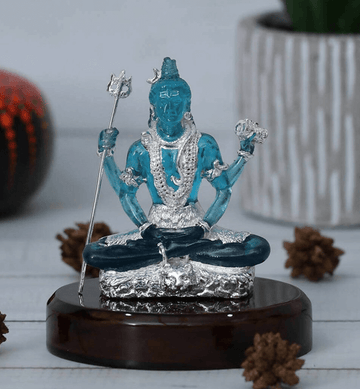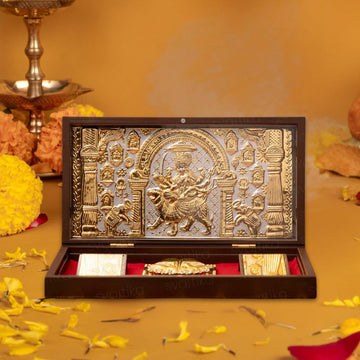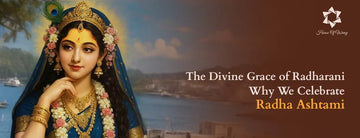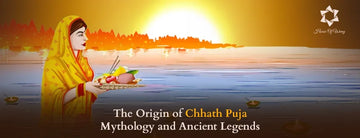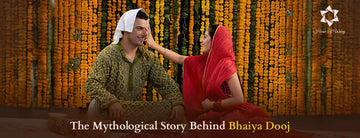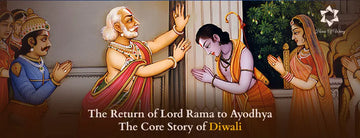While thinking of love, the first name that comes to mind is RadhaKrishna, the two names that can never be separated, just like the soul and the heart. Devotees celebrate Radha Ashtami each year to honor the birth of Radharani, Lord Krishna's eternal love. While Janmashtami marks Krishna's birth, Radha Ashtami focuses on the birth of Radharani, the source of absolute devotion.
We all have heard our grandmothers and mothers singing all day during the Shravana month,
“राधा बिना कृष्ण नहीं
कृष्ण बिना नहीं राधा।”
This sums up the significance of Radha in Krishna’s life. But why do we celebrate Radha Ashtami, and what is its spiritual depth? Together, let us understand Radharani’s divine grace.
Who Is Radharani: Her Divine Role in Hinduism
Among the various references in the Hindu scriptures, Radha is most commonly referred to as Radharani or Shrimati Radhika. She is not only a character from the Puranas, but she is considered the original Bhakti (devotion) itself. In Hinduism, she is the one to symbolize unconditional love.
- Radharani is worshiped by bhakts as an eternal partner of Krishna. She is the only one who can understand Krishna’s Leela (divine play).
- Saints usually say Krishna is nothing without Radha, pure devotion of Radha makes her heart of divine God.
- As per Vaishnavism, Radha is honored as the sacred goddess of kindness, dignity, and eternal love.
Devotees even keep a Radha Krishna photo frame at their home, not just as a piece of beauty, but to cherish the divine love and Radha Krishna devotion.
Spiritual Significance of Radha Ashtami in Vaishnavism
The spiritual Radha Ashtami significance is way more than just the birth ceremony of Radha. In Vaishnavism, Radhika is symbolized as the Shakti (divine energy) of Lord Krishna. Just like a diya is incomplete without a batti, Krishna’s Playtime (leela) is incomplete without his Radhe. The spiritual meaning of Radha Ashtami lies in understanding the divine grace of Radharani:
- Shrimati Radhika represents the soul’s need for union with the divine God.
- Radha’s life guides us that devotion is not prayer and following rituals, but pure devotion lies in the eternal love for the holy God.
- Radha signifies Bhakti Yoga, where surrender to God is the ultimate spirituality.
The Story of Radha’s Birth and Her Connection to Vrindavan
The story of Radharani’s birth holds a divine mystery. According to traditional information, she was given birth by Kirti Devi and Vrishabhanu at Barsana. Unlike other newborn babies, Radha did not open her eyes or cry at the time of birth.
- Remember our bedtime tales where our grandmothers used to say, “Radharani only opened her eyes when Bal Krishan came to meet her.” This act shows that Shrimati Radhika took birth only for her eternal love and devotion for Lord Krishna.
- Baby Radhika’s childhood was in Barsana, and when she grew up in Vrindavan, weaving endless leelas. Her endless love and selfless devotion for Kanha always guided generations of bhakts.
Radha and Krishna: Symbol of Divine Love and Devotion
RadhaKrishna is not just a name; together, they create an ideology. The importance of Radha in Krishna’s life is paramount because whenever Krishna is worshiped, devotees chant “RadheKrishna.”
- Radha’s love cannot be expressed in words. It is spiritual and never-ending.
- RadhaKrishna’s union is represented as an eternal dance commonly known as Raslila or Ras.
- Krishna symbolizes the Holy God, and at the same time, Radhe is described as the soul. Teaching us that the purpose of life is to unite with devotion and love.
How Radha Ashtami Is Celebrated Across India?
Celebrating Radha Ashtami for devotees is a joyful occasion, especially in their native places, Barsana and Vrindavan. The Vrindavan Radha Ashtami celebration is great and famous all over India. Every year, devotees specially visit Vrindavan temples to celebrate the birth of Radharani.
Here are some popular celebrations in India:
- At Barsana (Srimati Radhika’s birthplace), bhakts gather in temples, sing Radhakrishna bhajans, and perform their favorite Raslila dance.
- Temples like Banke Bihari and Radha Raman Mandir in Vrindavan have grand celebrations, with temples beautifully decorated, and sing kirtans in groups.
- In Mathura and nearby villages, a play of Radha Krishna leelas is organized by devotees to remember their eternal love and sacred bond.
-
In Vaishav households, Lord Radha Krishna idols are bathed in panchamrit (made of milk, curd, honey, and Pure cow ghee), also known as Abhishekam.
Puja Vidhi and Rituals Performed on Radha Ashtami
Bhakts perform Radha Ashtami pooja with great devotion and love towards Radharani. It’s deep with deep spiritual meaning:
- Firstly, take a bath with holy water (gangajl) and prepare for puja using complete pooja samagri.
- Place the Radha Krishna Photo frame or Idols in your pooja altar and worship at noon (Considered as Radha’s birth time).
- Observe upras (stay on fast from one day before Radha Ashtami).
- Take vows and express your wishes, and seek blessings from Radharani.
- Recite the Radha Ashtami Vrat Katha, then continue with Radha Stuti and Radha Chalisa.
- Gather the deity by chanting bhajans and prepare for aarti.
- Light a diya and do aarti, followed by offering bhog to the Goddess Radhika.
- The next day, feed Brahmins and married women to invite prosperity and divine energy.
- Lastly, break the fast by having prasad.
These Radha Ashtami rituals are not just traditions; they are deeds of devotion, sacrifice, and gratitude.
Fasting and Devotional Practices on Radha Ashtami Day
Devotees across India observe a fast on Radha Ashtami day, but practices may vary:
- In some families, women observe a nirajala fast (without food or water) for 24 hours.
- Many devotees only eat fruits and milk as a light fast.
- And in a few regions, special fasting dishes are prepared using sabudana (sago) and vrat-friendly ingredients.
Reciting Radharani’s birth story, chanting mantras, and performing Krishna leela while fasting is considered beneficial.
Radha’s Role in Bhakti Yoga and Spiritual Surrender
In the Bhakti tradition of Radha, she is considered a superior devotee. Her endless love and affection for Kanha were said to be unconditional and without any greed.
Bhakti yoga is all about:
- Kishori is symbolized as atma-nivedan (self-surrender of soul and mind)
- Her life lessons tell us about getting lost in devotion, and not about just seeking blessings.
- Radha’s devotion always inspired many sages, including Chaitanya Mahaprabhu. He used to see Radhika as the biggest devotee of Lord Krishna.
Bhajans, Kirtans, and Mantras Dedicated to Radharani
Temples and homes practice reciting mantras, bhajans, and kirtans on Radha Ashtami. Remembering her birth kathas and mantras is connected with her grace. Famous mantras and bhajans dedicated to Radharani are :
तपत-कांचन गौरांगी, राधे वृन्दावनेश्वरी ।
वृषभानु सुते देवी, प्रणमामि हरी प्रिये ॥
This mantra means:
I offer my respects to Radharani, whose bodily complexion is like molten gold and who is the Queen of Vrindavana. You are the daughter of King Vrisabhanu, and you are very dear to Lord Krishna.
मीठे रस से भरियो री,
राधा रानी लागे,
महारानी लागे,
मने कारो कारो,
जमुना जी रो पानी लागे ॥
This bhajan means:
O Radha Rani, you are pure sweetness and the ruler of hearts. Even the deep, dark waters of the Yamuna seem infused with your aura, reflecting beauty and divinity.
Lessons from Radha’s Life: Devotion, Grace, and Purity
Radha’s life is way more than just a story; it is a guide to spiritual devotion and endless love
Let’s learn some of her life lessons:
- Devotion: Loving your Lord without greediness is the best form of prayer.
- Self-surrender: sacrificing one's ego, attitude, and creating a divine bond with the Lord for true blessings.
- Radharani’s grace: Her divine grace gives us a life lesson of showing kindness to everyone in our everyday lives.
-
Balance of devotion and responsibility: Radha always reminds us to keep a balance of devotion while managing self-responsibilities.
If you also want to perform puja and rituals of the Radha Astami 2025 date and muharat are as follows :
- Sunday, August 31st.
- The Ashtami Tithi starts on August 30th at 10:47 PM and
- ends on September 1st at 12:59 AM.
So, now you know exactly why RadhaKrishna’s union is believed to be divine, and the rituals to perform on the next Radha Astami. Remember it’s not just a day but a reminder of the endless devotions: that without Radha, Krishna is incomplete, and without devotion, life is incomplete. Explore House of Wemy’s Radha Krishna Photo Frame to add divine love to your home.

